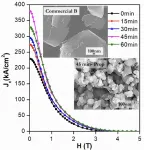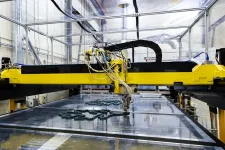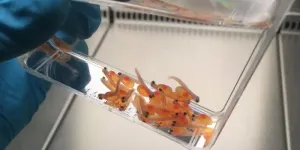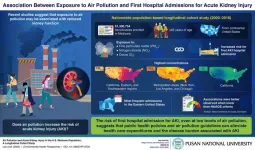Towards a sustainable superconductor technology with magnesium diboride super magnets
Scientists use ultra-sonication in 2-propanol to create high-performance bulk magnesium diboride superconducting magnets
2023-05-01
(Press-News.org) Magnesium diboride (MgB2), a binary compound, behaves as a superconductor – a substance that offers no resistance to electric current flowing through it – at a moderate temperature of around 39 K (-234°C). This temperature can be achieved using relatively inexpensive liquid hydrogen or neon coolants. In addition, MgB2 is inexpensive, lightweight, and non-toxic, and its precursors – magnesium (Mg) and boron (B) – are abundantly available. As a result, it can replace conventional low-temperature superconductors that require expensive liquid helium for cooling and substitute magnets based on neodymium, a rare element, as well as iron and boron.
MgB2 finds a wide range of applications, including the manufacture of coils and magnets for magnetic resonance imaging, nuclear magnetic resonance, magnetic drug delivery, fault current limiters, electric motors, and transportation. According to research, MgB2 is a good candidate for polycrystalline superconducting magnets as it exhibits good critical current density (Jc) and a high trapped magnetic field (TF). It, however, suffers from weak magnetic flux pinning. To enhance pinning, it is essential to tune the pinning centers in MgB2 – the boundaries of grains or small crystals that constitute MgB2. To this end, researchers have now shown how nano-sized B particles can be used as B precursors to fabricate nano-sized MgB2 grains with strong grain boundary pinning and high Jc.
Currently, B nanoparticles are produced by ball milling, pyrolysis, and sintering. These techniques, however, suffer from drawbacks such as low purity output and poor cost-effectivity, necessitating better alternatives. To this end, a group of scientists led by Prof. Muralidhar Miryala from Shibaura Institute of Technology (SIT), Japan recently explored high-energy ultra-sonication as a cost-effective alternative for refining coarse B powder dispersed in 2-propanol up to nanoscale sizes. Their work was made available online in the Journal of Alloys and Compounds on 14th April 2023.
“In this technique, ultrasonic vibrations impart high speeds to B particles in the solvent, leading to collisions. The resulting friction and shear tearing, compression, and energy release by the collapse of tiny air bubbles produced during collision break down B particles to nanometer sizes,” explains Prof. Miryala.
Using 2-propanol as the solvent for B, the researchers ultrasonically refined cheap commercial B powder for 45 minutes to produce oxide-free nm-sized B particles. They then utilized them to fabricate bulk MgB2 with scarce oxide and no carbon impurities, which showed superconductivity at around 38.5 K. Furthermore, it showed high Jc values of 500 and 380 kA cm-2 at 10 K and 20 K, respectively. The latter of these Jc values marked an 80% improvement compared to that for bulk MgB2 prepared from cheap B powder and was at par with that for expensive commercial B powder. The observed increase in Jc was due to better grain boundary pinning in MgB2 as revealed by microstructural analysis, and theoretically supported by the Dew–Hughes theory.
Finally, the researchers performed field cooling magnetization simulations, predicting that a 40-mm wide and 10 mm-thick MgB2 disk prepared from ultrasonically refined B powder can exhibit a high TF of 2.5 teslas. “These findings bring MgB2 superconducting magnets, which can be fabricated in the form of tapes, wires, and films, a step closer to their commercialization,” envisions Prof. Miryala.
Indeed, with a sustainable and low-cost technique for developing high-performance MgB2 superconductors, the present work could unlock the potential of MgB2 super magnets!
***
Reference
DOI: https://doi.org/10.1016/j.jallcom.2023.170146
About Shibaura Institute of Technology (SIT), Japan
Shibaura Institute of Technology (SIT) is a private university with campuses in Tokyo and Saitama. Since the establishment of its predecessor, Tokyo Higher School of Industry and Commerce, in 1927, it has maintained “learning through practice” as its philosophy in the education of engineers. SIT was the only private science and engineering university selected for the Top Global University Project sponsored by the Ministry of Education, Culture, Sports, Science and Technology and will receive support from the ministry for 10 years starting from the 2014 academic year. Its motto, “Nurturing engineers who learn from society and contribute to society,” reflects its mission of fostering scientists and engineers who can contribute to the sustainable growth of the world by exposing their over 8,000 students to culturally diverse environments, where they learn to cope, collaborate, and relate with fellow students from around the world.
Website: https://www.shibaura-it.ac.jp/en/
About Professor Muralidhar Miryala from SIT, Japan
Dr. Muralidhar Miryala is a Professor at the College of Engineering/Graduate School of Science and Engineering and a member of the Board of Councilor at Shibaura Institute of Technology (SIT). He is also the Chair and OB at World Technology University Network (WTUN). His primary research interests comprise solid state physics and materials science, particularly materials for energy and the environment, such as high-temperature superconductors. He has over 500 publications to his credit, including patents, books, review articles, research articles, press releases, etc. He has received several awards for his research contributions, including the prestigious 2021 Pravasi Bharatiya Samman Award from the President of India and the SIT Excellent Education Award (2021) by the Chairman of the Board of Directors.
Funding Information
This study was partly supported by Shibaura Institute of Technology (SIT) International Research Center for Green Electronics and Grant-in-Aid FD research budget code: 721MA56383 and the Strategy AV21 of the Czech Academy of Sciences, the research program AV21-VP3 “Energy storage in flywheels.”
END
[Attachments] See images for this press release:

ELSE PRESS RELEASES FROM THIS DATE:
2023-05-01
Boston, MA - Hebrew SeniorLife, a Harvard Medical School-affiliated, integrated system of health care, senior living, research, and teaching that serves more than 3,000 Greater Boston seniors each day, announces the appointment of Steve Landers M.D., MPH as its new president & chief executive officer.
Dr. Landers comes to Hebrew SeniorLife from Visiting Nurse Association (VNA) Health Group, Inc., one of the oldest, largest, and most respected home health, hospice, and community health organizations in the country, where he has served since 2012 as president and chief executive officer. He is a practicing physician, certified in family medicine, geriatric medicine, and ...
2023-05-01
At the end of 2022, the federal government eliminated the “X waiver,” a major hurdle to providing addiction treatment, but progress needs to be continued, according to the authors of a new Perspective piece published in the New England Journal of Medicine. The X waiver required a special license and uncompensated training for physicians and other prescribers, creating a regulatory barrier to offering lifesaving buprenorphine treatment for opioid use disorder. Ending the X, the authors write, is necessary but not sufficient to achieve overdose-prevention goals.
Sarah Wakeman, MD, Medical Director for Substance Use Disorder at Mass General Brigham, and her co-author ...
2023-05-01
CHAMPAIGN, Ill. — The mechanics behind the collapse of soft materials structure have befuddled researchers for decades. In a new study, researchers uncover a metric that finally correlates microscopic-level processes with what is seen at the macroscopic level.
The new metric is poised to help bring advances to various materials engineering challenges – ranging from the formulation of better 3D printing inks, the construction of wearable flexible electronics and sensors, the accurate printing of biomedical implants, to helping control landslides and avalanches, and ...
2023-05-01
(Boston)–Five Boston University Chobanian & Avedisian School of Medicine faculty have been honored as 2023 Educators of the Year by the School’s Awards Committee. Nominated by students and faculty, the annual awards recognize School of Medicine educators who provide excellence in teaching and mentoring.
This year’s recipients are Ricardo Cruz, MD, MPH, Educator of the Year, Preclerkship; Julia Bartolomeo, MD, Educator of the Year, Clerkship; Lillian Sosa, MS, CGC, Educator of the Year in MA/MS Programs; Douglas Rosene, PhD, ...
2023-05-01
(Boston)—Sean D. Tallman, PhD, RPA, assistant professor of anatomy & neurobiology at Boston University Chobanian & Avedisian School of Medicine, has been awarded a Fulbright Scholar Award. This award allows U.S. academics to engage in multi-country, trans-regional projects.
Tallman will travel to South Africa for 10 months to conduct human skeletal biology research for his project, "Assessing the Effects of Disadvantage and Ancestry in Skeletal Health and Forensic Medicine" at the University of Cape Town and Stellenbosch University.
Tallman ...
2023-05-01
Photonic chips have revolutionized data-heavy technologies. On their own or in concert with traditional electronic circuits, these laser-powered devices send and process information at the speed of light, making them a promising solution for artificial intelligence’s data-hungry applications.
In addition to their incomparable speed, photonic circuits use significantly less energy than electronic ones. Electrons move relatively slowly through hardware, colliding with other particles and generating heat, while photons flow without losing energy, ...
2023-05-01
INDIANAPOLIS – A new study conducted by researchers from Regenstrief Institute and the universities of South Carolina and Indiana has found that the most commonly prescribed blood pressure medications, taken for at least six months prior to an intensive care unit (ICU) admission, did not protect against developing delirium in the ICU, regardless of patient age, gender, race, co-morbidities or insurance status.
Delirium, an acute brain failure, affects approximately seven million hospitalized patients in the U.S. annually and is associated with longer hospital and ICU length of stay, higher likelihood ...
2023-05-01
[LOS ANGELES (May 1, 2023) — While Wilms tumor—also known as nephroblastoma-- is rare, it is the most prevalent childhood kidney cancer. Researchers at Children’s Hospital Los Angeles have now pinpointed a disruption in early kidney progenitor cell development that can be linked to the formation of Wilms tumor.
In a study published in Advanced Science, researchers at the GOFARR Laboratory in Urology compared kidney progenitor cells from a tumor with precursor cells from a healthy kidney. Normally, these precursor cells mature into kidney cells, but when their early development is dysregulated, they behave like cancer stem cells.
While most children ...
2023-05-01
Researchers, including from NTNU, are breeding bacteria-free fish fry. This pursuit is more important than you might think.
“We’re managing to keep the fry bacteria-free for up to 12 weeks after the eggs hatch,” says Ingrid Bakke. She is a professor at NTNU’s Department of Biotechnology and Food Science.
This step has now helped researchers on the trail to figuring out how bacteria and fish affect each other. Understanding their interaction could one day also lead to a method ...
2023-05-01
Acute kidney injury (AKI) is a clinical syndrome characterized by a decrease in kidney function. AKI is very common in the United States' Medicare population, particularly among hospital intensive care unit (ICU) admissions. Furthermore, AKI is associated with the incidence of end-stage renal disease, which eventually increases the burden of long-term care, higher health-care costs, and increased mortality.
In several instances, kidney diseases have been linked to air pollution exposure. Inhaling air pollutants, including gases like nitrogen dioxide (NO2), ozone (O3), and fine particulate matter (PM2.5) that remains suspended in ...
LAST 30 PRESS RELEASES:
[Press-News.org] Towards a sustainable superconductor technology with magnesium diboride super magnets
Scientists use ultra-sonication in 2-propanol to create high-performance bulk magnesium diboride superconducting magnets




